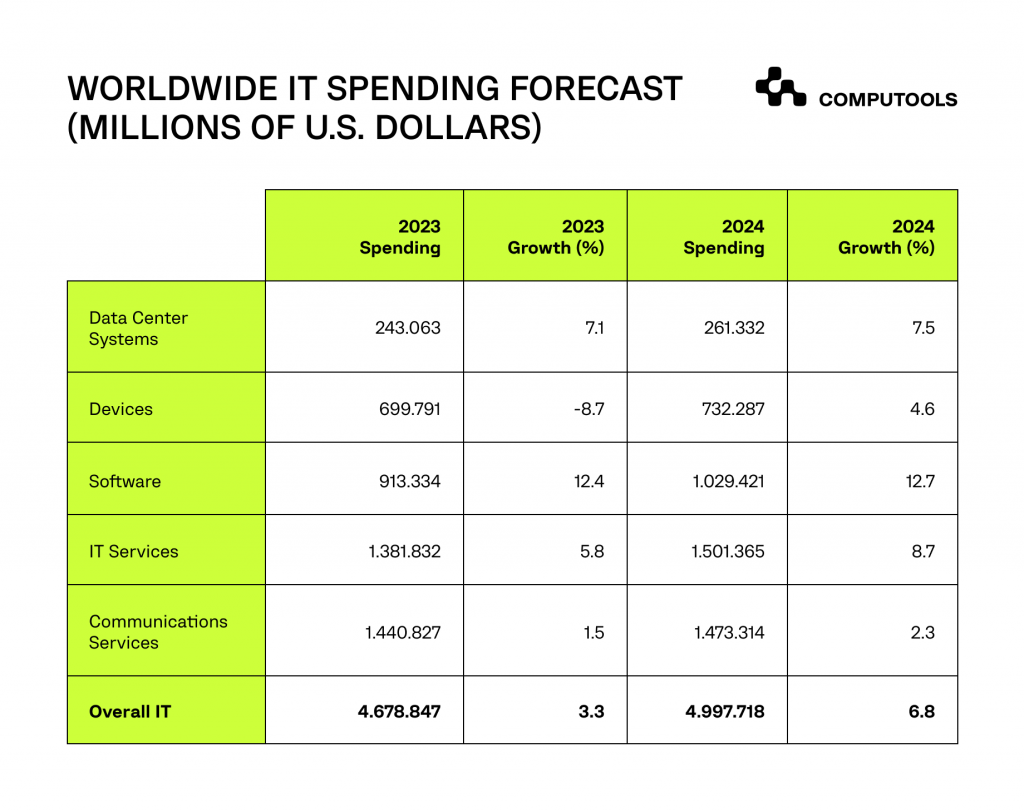Regardless of whether the global economy officially goes into a recession, companies continue to face significant economic challenges that threaten their stability, growth, and profitability.
If you want to learn how to create an effective IT and digital strategy to permanently lower business costs, enhance the experiences of customers and employees, take advantage of groundbreaking innovations, and surpass competitors during economic downturns, then this article is for you.
Understanding the Impact of IT on Business Stability
Companies often seek ways to streamline processes and cut costs during recessions, typically turning to automation and tech-driven solutions.
Technology, especially the combined power of Artificial Intelligence, Big Data, and the Internet of Things, is quickly becoming capable of helping businesses achieve more with less and deliver better results.
Businesses now leverage these solutions to shorten the time from product concept to creation and from creation to customer delivery, all while employing fewer workers.
Costs can also be reduced as automation and robots take over roles traditionally filled by humans who require wages and benefits. And organisations that don’t adapt to these changes risk falling behind.
You’ve likely heard the term “digital transformation” often over the past few years. In short, it means adopting Software Engineering services to change business processes from non-digital to digital.
Statista reports that in 2022, the most common ways organisations tackled digitalisation were by reusing and repurposing existing solutions with traditional infrastructure
The study also revealed that either modernising their existing systems or fully embracing transformation is a priority for 45 percent of the surveyed CIOs.
Gartner also notes that more and more companies are investing in IT and digital strategy development. It’s predicted that global IT spending will reach US$5 trillion in 2024, up 6.8% from 2023.
But what digital initiatives should you prioritise, and how do you make the right choices? We’ll address these questions in this article.

Building a Digital Strategy to Evade Economic Decline
There are plenty of opportunities to navigate and come out ahead of today’s economic headwinds.
Here are the steps to create a digital strategy that will allow you to make smart digital investments at the right cost.
1. Clearly Define Your Goals and Desired Outcomes
Effective digital leaders clearly outline their digital goals, specifying how deeply they plan to use digital technologies and methods to boost tangible business outcomes.
To achieve this, you can begin by distinguishing between digital optimisation and transformation. The perfect digital strategy should both optimise and transform your processes.
• Digital optimisation enhances current operations and business models while maintaining the overall structure of the business.
It involves operational adjustments, such as digitising key capabilities to support your business proposition or profit model.
By focusing on optimisation first, you can lay the groundwork for broader transformations in the future.
• Digital business transformation, on the other hand, alters 3 of the 4 key elements of a business model: target audience, value propositions, capacity, and financial model, changing the way a company delivers value to the market segments it targets.
While complete overhauls of the enterprise business model are uncommon, transformation usually happens gradually and affects different parts of the business one at a time.

2. Build Your IT Digital Maturity
No matter your strategic goals, it’s important to choose digital projects carefully to prevent overextending your focus and resources.
Digital maturity in the organisation comes from combining four interrelated capabilities: strategy, management, architecture, and technology implementation.
To achieve your enterprise’s objectives, you need to invest in these four key focus areas:
• A digital strategy requires outcomes focused on both digital transformation and optimisation, but the balance between these depends entirely on your goals.
• Management is about setting up decision-making processes within your organisation.
In mature enterprises, good decision-making is aligned with value, risk, and strategic impact.
• Enterprise architecture needs to convert business strategy into actionable business outcomes and detailed action plans.
These plans should direct, execute, and advance business capabilities, value streams, business processes, and IT decisions, as well as updates to the underlying IT infrastructure.
• Technology implementation ensures that appropriate internal IT services are provided at the anticipated cost and quality levels to maintain IT-enabled business capabilities and assets over the long term.
3. Prioritise IT Investments For Businesses
Even with the challenge of high-interest rates affecting funding, there remains a strong demand for digital investments.
Notably, 80% of business owners are planning to raise their technology budgets by at least 3%, with 43% aiming for an increase of 10% or more.
Organisations must adopt a formal process to evaluate, measure, and prioritise IT spending, linking these investment decisions directly to the organisation’s main business objectives.
These include:
• Increased revenue
• Reduced costs
• Risk mitigation
• Enhanced quality
• Accelerated time to value
• Efficiency gains
Whatever your goals, you have to prioritise and assess each objective to confirm your key business outcomes and create an executable list of IT investments that support these outcomes.
4. Find and Solve Talent Challenges
Despite the increase in layoffs in the tech industry, there remains a shortage of digital talent, which is still expensive, particularly in specialised skill areas.
You should identify your enterprise’s specific talent challenges to create strategies and tactics designed to address them.
In a short perspective, as part of your recession investments, you might find opportunities to hire digital experts from companies that are downsizing.
It’s important to seize these chances to get top digital talent at a lower cost, especially since other companies might be taking advantage of the same opportunity.
In the long perspective, apply a structured framework, which uses a life cycle approach to managing digital talent, covering everything from recruitment to retention, and eventual talent release to ensure that you place the right people in the right roles.
CEOs and IT leaders can adopt this method to pinpoint and prioritise technology skills and talent requirements, and then develop methods to evolve the workforce as business and digital transformation priorities change.
5. Reevaluate the Employee Value Proposition (EVP)
The drastic changes in work models during the pandemic showed that to attract and keep digital talent, you must revise your Employee Value Proposition (EVP), or what employees can anticipate in exchange for their skills, abilities, and experience.
This includes adopting a human-centred approach — creating policies that prioritise people, taking into account their life experiences and emotions.

6. Avoid Cost Reduction Mistakes
When faced with economic difficulties, organisations often prioritise cutting costs. It’s important to avoid spending management mistakes that could hinder the financial well-being and growth of your organisation.
Even when taking a strategic approach to managing costs, business owners will often face immediate pressures to reduce expenses.
You must handle these reductions carefully to minimise damage to the business’s long-term success.
Here are three common mistakes you might make:
• Your costs keep going up because of inflation, making your profit margins unsustainable.
• You cut costs too much, and when demand picks back up, you can’t keep up.
• Raising your product prices ends up costing you market share for good.

Computools
Software Solutions
Computools is an IT consulting and software engineering company that delivers innovative solutions to help businesses unlock tomorrow. Our clients represent a wide range of industries, including retail, logistics, finance, healthcare, and others.
7. Invest in IT Through Cost Optimisation
When done properly, strategic cost optimisation for business uses a structured, collaborative approach to review spending and costs, helping you maximise your existing resources and redirect savings toward investments that promise greater business value.
To avoid underfunding digital initiatives, make sure you’re not just depending on savings from other budgets to support them.
Scaling digital efforts typically needs bigger funding than what can be trimmed from the IT budget alone.
You have to be clear about both the costs and advantages of the promised business value and maintain strong connections with the Financial Director to secure funding for digital investments.
IT teams must also have a transparent understanding of their IT spending to ensure it’s strategically aligned.
High-performing organisations often review and compare their spending to different cost perspectives to encourage better business outcomes.
To do the same:
1. Set a baseline for your total IT spending and staff levels.
2. Compare your total IT spending to that of industry peers.
3. Identify areas for improvement.
4. Improve IT cost management by considering spending from various perspectives.
5. Set targets for future budgeting or efficiency.
6. Adjust IT spending to better correlate with business value.
7. Report on performance to stakeholders within your organisation.
8. Create a compelling story about how IT spending is strategically aligned to support business objectives.
8. Supervise Vendors and IT Contracts
Negotiations with IT vendors are complicated even under the best economic conditions, and factors like inflation and economic downturns introduce additional complexities.
You have to closely supervise IT vendors to assess if price increases and high recurring costs are justified based on economic conditions.
Consider that specific technologies are key to aggressive price-forming strategies.
For instance, as the public cloud becomes the main innovation for modern working environments and user spending on it increases, mistakes in cloud migration can lead to escalating costs.
Therefore, planning a cloud-first digital optimisation for businesses should involve early decisions about solutions and providers, and the same is true for cybersecurity services.
9. Meticulously Evaluate Vendor Proposals
As digital strategy is critical in times of crisis, negotiations with vendors can become more complex.
However, technology proposals must be comprehensive enough for IT teams to dissect the terms and spot hidden or missed costs.
We suggest a four-step method for analysing and negotiating multiyear Software Engineering agreements:
1. Collaborate with stakeholders to predict IT usage and plan the implementation.
2. Request time-and-material proposals from vendors to compare with options for multiyear prepayments.
3. Determine the net present value (NPV) of their flexible payment options to weigh against prepayment plans.
4. Use NPV to prepay strategies and comparisons to help negotiate better prices and terms.
10. Create a Technology Roadmap
A technology roadmap is a strategic plan that shows how an organisation’s IT projects will help achieve its business goals.
It usually includes documents that help illustrate the journey from the current situation to the desired outcome.
Effective roadmaps highlight key milestones and steps needed to turn strategy into action within a specific timeframe.
The goal of technology roadmapping is simple — to predict technology trends and plan what digital transformation services you’ll need. However, the process can be complex.
Here are four best practices for creating effective technology roadmaps.
1. Develop a systematic approach for creating and updating roadmaps using standardised templates and instruments that ensure consistency and clarity.
2. Customise roadmaps to the needs of different audiences, providing the detalisation needed to generate excitement about the strategic direction.
3. Enhance decision-making speed by maintaining links between roadmaps and using business results metrics.
4. Boost the use of roadmaps by making them easily accessible and promoting them to their target users.
Final Thoughts
Today, organisations have access to far more digital tools and capabilities than they did during the previous financial crises.
However, wise digital investment requires focusing on unique factors that will drive long-term success.
Failing to invest wisely in digital technologies now will only escalate your technical debt. Furthermore, your competitors will forge ahead in developing digital products and services, potentially luring away the talent you need.
We hope that you’ll approach our recession tips thoughtfully and extract the utmost value from these insights.
If you want to know more about our digital transformation services, contact us at info@computools.com to schedule a consultation with our experts.









“Computools was selected through an RFP process. They were shortlisted and selected from between 5 other suppliers. Computools has worked thoroughly and timely to solve all security issues and launch as agreed. Their expertise is impressive.”